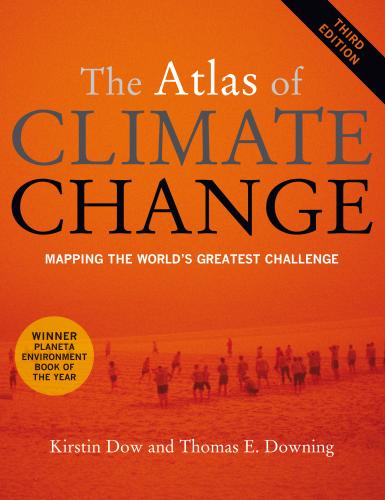Climate change has a taste, it tastes of salt. Atiq Rahman UNEP Champion of the Earth 2008, Director, Bangladesh Centre for Advanced Studies
21
Warning Signs
USA: heat wave
Among the thousands of warning signs of climate change, the array of extreme events that took place in 2010 stand out. Current climate change is affecting all continents and most oceans. Thousands of case studies of physical changes (such as reduced snow cover and ice melt) and changes in biological systems (such as earlier flowering dates and altered species distributions) have correlated with observed climate changes over the past three decades and more. Scientists have high confidence that these environmental changes are part of the early warning signs of climate change. Effects on social and economic activities are harder to attribute to climate impacts, although major events attract considerable attention. From prolonged drought in Africa and Australia to the dire flooding in Australia, China, and Pakistan, livelihoods, economies, and politics are at risk. A single extreme weather event or change in the natural environment does not prove that humans are changing the climate. However, the proven physical science, the history of recent observations, and the consistency in model assessments all support only one explanation: the emission of greenhouse gases by human activity is causing profound changes to the climate system and to the world we live in. The pace of change appears to be accelerating. Reports of sea levels rising faster than previously expected, of new temperature records, of an increasing toll of weather-related disasters, and anecdotal stories of impacts on livelihoods are accumulating. The year 2010 tied as the warmest year since records began in the 1850s, and threw up an astonishing series of extreme events. Increases in global average air and ocean temperatures, widespread melting of snow and ice, and rising sea levels led the Intergovernmental Panel on Climate Change (IPCC) to report in 2007 that “warming of the climate system is unequivocal”. As evidence continues to mount, that statement is even truer today.
In 2010, a very large area of the USA experienced high temperatures over an unusually long period. Downtown Los Angeles set an all-time record high temperature at 45°C in September 2010. Fires started in the hills and spread to residential areas.
22
Russia: state of emergency
In 2010, a heat wave claimed 15,000 lives, with 7,000 deaths in Moscow alone. A state of emergency was declared in seven Russian regions, where tens of thousands of hectares of land was destroyed by fire, and hundreds of people were uprooted from their homes. As Russia’s grain output was slashed by 40%, a grain export ban was imposed.
China: floods
Flood waters from southwest to northeast China, including the municipality of Chongqing, shown here, led to the evacuation of 15 million people by the end of August 2010. Over 3,000 people died, and damage was estimated at over $50 billion.
Australia: floods
December 2010 was the wettest on record for Queensland. The floods that resulted in January 2011 led to at least 22 deaths and affected more than 200,000 people. Taking into account the impact on the Australian economy, the cost is estimated in the region of $30 billion.
Pakistan: floods
Pakistan’s monsoon rains in late July 2010 were unusually heavy, with 300 mm falling over the headwaters of the Indus in 24 hours. As the water moved downstream over the subsequent weeks, an estimated fifth of the country was inundated. More than 1,600 people were killed, and about 20 million displaced. Preliminary estimates placed the total damage at $15 billion.
24–25 Polar Changes; 26–27 Shrinking Glaciers; 28–29 Ocean Changes; 30–31 Everyday Extremes
23
Warming in the Antarctic Peninsula and Arctic is driving large-scale melting of ice that will have both local and global consequences. The presence of a hole in the ozone layer over the southern polar region has altered weather circulation patterns on Antarctica. It has brought more warm, moist, maritime air over the Antarctic Peninsula, contributing to warming and melting there, but has created a cooling effect in other areas. As the ozone hole recovers, that cooling effect is expected to diminish. In East Antarctica, the changes are much less dramatic than those on the Peninsula, with some melting and thinning on coastal edges and some thickening in the interior. In West Antarctica, however, a coastal section of the ice sheet is now thinning quite rapidly. Floating Arctic ice has covered the North Pole for millions of years. Its extent fluctuates with the seasons, but eight of the ten lowest extents have occurred in the last decade. The remaining ice is
also thinner, with approximately 50 percent of the maximum recorded thickness having been lost by 2008. Already, the North Pole is free of ice in some summers. In September 2007, the Arctic ice cap shrank to its smallest recorded extent, opening up the possibility of commercial shipping routes operating for the first time along the northern coasts of Canada and Russia. Some projections suggest that sea ice will disappear completely in the summer months by 2080. While an open Arctic sea would facilitate shorter trade routes, industrial-scale fishing and the exploitation of minerals, it would be at great cost to the environment and to traditional livelihoods. A delay in the formation of the winter ice, an earlier break-up of ice in the spring, and thinner ice year round makes it hard for indigenous people using largely traditional methods to make a living.
Polar Changes
Collapsing ice shelves The collapse of the Larsen A Ice Shelf in 1995 was followed by that of the Larsen B Ice Shelf in 2002. Over the last century nearly 20,000 sq km (7,720 sq miles) of ice shelf was lost on the Antarctic Peninsula.
Melting ice and sea-level rise
Melting of floating sea ice and calving of glaciers into the ocean do not affect the sea level. Ice displaces about the same volume of water as it produces when it melts. However,
